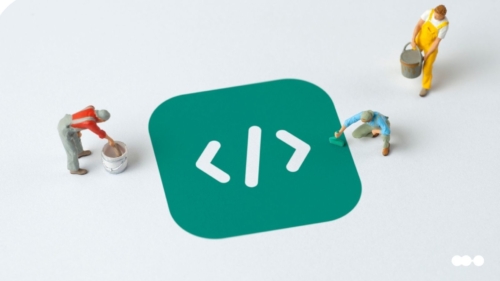ARTICLE SUMMARY
Competition for talent has reached historic highs, so it’s essential for companies to build hiring processes that attract qualified candidates.

The Society of Human Resources reports that the average U.S. employer spends 42 days to find the right candidate and about $4,129 to hire them. Recent LinkedIn data shows that some positions take up to 49 days. This raises an important question: can your business afford to wait that long?
This article maps out a hiring process workflow and illustrates how to build a hiring process that protects your team’s time, is respectful of applicants, and positions you to minimize the costs of turnover or failed hiring efforts.
But before we get to the hiring process steps, let’s review a few basics. (Feel free to skip down using the jump links at the top of the article.)
What you need to know before defining your hiring process
An organized hiring process empowers companies to find and hire the right employee with efficiency and ease – keeping the cost-to-hire and time-to-fill expenses down. A hiring process that is inefficient or one that results in no hire (or, worse, a bad hire) wastes valuable business resources and puts your company at a disadvantage.
Hiring vs. recruiting: What’s the difference?
While hiring and recruiting are closely related processes, each plays a distinct role in helping businesses grow by securing qualified talent.
Businesses use a hiring process to fill a particular and immediate opening in the company. The recruiting process refers to an ongoing effort to identify highly qualified candidates and help them learn about your company and potential openings, even if a specific position is not available at the moment.
| Hiring | Recruiting |
|---|---|
| – Fills immediate company needs – The goal is to hire so as to keep hiring costs down | – Used as a long-term strategy – The goal is to reach passive candidates and promote the company to a network of potential hires. |
Recruiters and talent acquisition (TA) specialists think beyond immediate hiring needs and work on building and promoting companies to meet future growth.
If there is a shortage of a particular kind of candidate within your industry, recruiting can help you connect with skilled employees who can fill that need, and increase the chances of finding the right candidate.
Over 70% of candidates are passive job seekers.
Internal vs. external hiring
There are two candidate pools that companies can pull from to fill job openings: internal (hiring from the existing workforce) or external (seeking talent from outside of the company). Today, internal hiring is at the root of a new workforce trend: internal mobility.
Deloitte data shows that empowering employees to grow within a company not only keeps them engaged, it improves employee retention and builds better leaders.
Use this 12-step hiring process to reach candidates
Every hiring process is unique, so what may work for one company or one industry may not work for another. The following framework includes the most common elements of the hiring process and can be adapted depending on the role, industry, and company policy.
This 12-step framework helps build a consistent, efficient hiring process that improves both candidate and employee experiences. This framework is divided into five phases: planning, identifying, interviewing, assessing, hiring, and onboarding. Here’s what the framework looks like in action and how automation can help.
Phase 1: Plan
Step 1: Define the hiring need. Simply knowing the job title for which you are hiring is not enough. You must define role expectations and essential qualifications that the hire must possess. If it’s a new position, carefully assess how it relates to other roles at the company, and what value the new position should provide to the company.
During this planning phase, also consider how you’d like to promote the role and where, whether to consider internal candidates and how you’ll assess skills.
Step 2: Establish a timeline. Define how fast you’d like to fill the role and how long you’re willing to go with a vacant role before it begins to impact productivity.
Keep in mind: The more expertise required for the position, the longer it may take to find the right candidate. Also, in-demand candidates may be scooped up by a competitor if you let your hiring process run on for too long; strive to be as efficient as possible in your hiring timeline.
Phase 2: Identify
Step 3: Promote the open position and start attracting candidates. Be strategic with your posting: post to job boards to reach candidates actively seeking new roles; share on social media to pique the curiosity of qualified, but passive, applicants.
Clearly indicate the duties the position entails, which department it is part of, and the essential qualifications you are looking for. By also indicating a salary range, you can attract more candidates or avoid applicants who would not end up accepting the position because the salary is too low for them.
Step 4: Track and identify qualified applicants. A typical corporate job opening attracts 250 applications, so tracking all of the application data can be challenging, especially if you accept job applications through multiple channels. It’s important to take a systematic, organized approach for tracking applications and managing the documents within each one. Using BPA software can keep applications in order, hiring managers up to date on qualified applicants, and candidates up to date on the status of their application.
| Automation tip #1: If a candidate meets all the requirements defined in Step 1, automate the applicant intake to automatically alert hiring managers and kick off the application review process. |
Phase 3: Interview
Step 5: Interview candidates. Interviewing is one of the most intense, and important, parts of the hiring process. While the typical job interview consists of stakeholders (hiring manager + team leader + potential teammates) posing a set of questions to the candidate, this isn’t always the best way to assess applicants – especially in today’s remote-first environment.
Consider sharing at least some questions with the candidate before the interview, so that they come in with well-thought-out answers. This will give you insight into how the candidate thinks when given the chance to evaluate a problem fully.
| Automation tip #2: Set up automated emails so that candidates are informed of next steps once the hiring manager approves their application. |
Phase 4: Assess
Step 6: Evaluate candidates. After you’ve conducted interviews, carefully assess each candidate on the basis of factors such as demonstrated skill sets, work history, and enthusiasm about your company and mission. Establish a consistent set of criteria to assess candidates, and gather notes from other stakeholders for a balanced assessment.
Step 7: Notify candidates of application status. Be sure to reach out to candidates — whether you intend to move forward with them or not — in a timely manner so as to not waste their time. This also encourages interviewees to leave positive reviews of their experience with your company, which bolsters your overall brand and helps you recruit effectively in the future.
| Automation tip #3: Improve the candidate experience and keep the process flowing smoothly by sending out an automated email to applicants that are no longer in consideration. |
Step 8: Complete background checks. For the leading candidate or candidates, it’s wise to conduct background checks and reference checks before extending the offer, when possible. This will not only expedite the hiring process, but will also raise any potential red flags that need to be considered.
| Automation tip #4: Once candidates are selected, automatically alert the appropriate stakeholders for Step 8. Never miss a beat by integrating your existing software with your business process automation platform. |
Phase 5: Hire
Step 9: Make an offer. The background check cleared and the candidate is the right fit, so it’s time to make an offer. Before reaching out to the candidate, but sure to have salary and benefits associated with the job outlined, in addition to work expectations and an expected start date in mind.
If the offer terms are truly non-negotiable, make that clear when you make the offer. Otherwise, expect most candidates to seek to negotiate the terms.
Step 10: Provide a contract. Once the employee has informally accepted the offer and terms via phone or email, it’s time to formalize it with a contract. Because there are so many variables and considerations, and employment laws vary among states, it’s wise to consult an employment lawyer when creating your contract.
Step 11: Acceptance of offer. It’s common courtesy to give a new hire a day or two to review the formal employment contract before signing. Once he or she has signed, it signals formal acceptance of your offer, binding both you and your new employee to the terms of the contract.
| Automation tip #5: HR automation software can seamlessly transition the candidate into new hire status and begin the onboarding workflow. |
Phase 6: Onboard
Step 12: Begin the onboarding process. The candidate is officially a new hire, so the next and final step is onboarding. Make it clear who will oversee the onboarding process, when it will begin and how long it will last.
Today, it’s common practice to begin this process before the new hire’s first day so as to transition the employee smoothly into their new role. Once the new hire joins the company officially, they will begin learning about company systems and culture, procedures and expectations, and gain any necessary training for their new role.
| Automation tip #6: Once the hiring process is complete, alert other departments involved with the onboarding process – such as IT, finance, legal employee education – to prepare for the new hire’s first day. |
Interviewing candidates – what to do – or not:
Now we’ve gone through the steps of your hiring process and you know just where the “interviewing candidates” part fits, let’s take a look on what you can do – or don’t do – to ensure you’ll have the best results out of it.
What to DO:
We’ve gone over the importance of preparing in advance time and time again. Review what you’ve specified on the job description and look for the determined requirements. Know what you’re looking for in a candidate before beginning the interviewing process.
- Have at hand a list of standard – but not mechanically scripted – questions to ask all candidates, their education, skills, abilities and past work experiences.
- Specify in advance the criteria – and their importance order – you’ll analyse your candidates on. Having defined criteria will help you evaluate all candidates fairly according to the same parameters.
- Review the candidate’s resumé prior to the interview, set reasonable time limits and appointment times.
- Look and act professional during the interviews. In a businesslike atmosphere, dress appropriately and demonstrate you’re genuinely interested in the interview.
- Collect pertinent information when interviewing candidates – look for behaviour patterns that can help you trace the candidate’s profile. Extracting the right information about past experiences is likely to give you enough to have a good idea on how this candidate will behave in the future.
- Don’t give up essential information upfront, avoid giving candidates the ability to formulate beforehand the ideal answers to your company’s needs. Don’t answer your questions for them and pay attention if any answer looks too scripted and said just to impress you.
- Notice how well the candidate listens, interprets and answers the questions you present them. Interpret their choice of words as well as non-verbal behavior.
- Specify and structure your questions regarding specific problems that may come up in the job position you’re interviewing for. Try to extract information from past experiences in particular situations.
- Use the list of standard questions you’ve developed during each and every interview – treat all applicants the same and ensure you won’t be comparing apples to oranges.
- Stimulate the candidate to ask you questions – and explore the reasons of the questions they choose to ask. The ones he/she asks first are most likely his/hers primary concerns and/or reasons for applying for this job.
- Use the criteria you’ve specified before the interview to guide your information recording and help you set candidates apart from each other.
- Organise and analyse the information you wrote down as soon as possible after the interview, to benefit from fresh memories. Don’t count on yourself to remember everything that was said – that’s what notes are for.
- Ask only job-related questions and don’t forget to focus regarding the criteria.
- Explain the selection process to the candidate. Offer realistic time frames and stick to your word! Don’t say you’ll get back to them if you don’t intend to.
What NOT to DO:
Some subjects are widely regarded as off-limits for any discussion in job interviews. Many of them are related to employment laws, specially regarding equal employment opportunities. Seek the guidance of your legal department to help you determine the best ways of approaching candidates. Here are a few topics you’re widely advised to refrain from – either when interviewing candidates or seeking applications:
- Race and ethnicity;
- Age;
- Arrest record;
- Candidate’s legal status as a citizen of your country (in the US, it’s acceptable to ask for proof of eligibility to work in the country);
- Ancestry, birthplace or native language (it’s acceptable to assess whether the candidate is able to speak foreign languages, if applied to the job opportunity);
- Religious customs/Specific holidays;
- Height and weight (if unrelated to the ability of performing the job);
- Relative’s information (unless those candidates that have relatives current or past organisation’s employees);
- Housing situation (whether they own or rent their home, who lives with them, etc.);
- Financial situation (unless their credit history may be considered job related – even so, proceed with caution);
- Education/skills (unless they’re specifically required to perform the job);
- Sex or gender (act appropriately and avoid any language or behaviour that could possibly be considered inappropriate);
- Pregnancy/medical history;
- Family or marital status (asking whether they’ll need child-care arrangements is permissible to assess whether the candidate is able to work the required hours);
- Physical or mental disabilities (you can ask whether and how they’d be able to perform essencial job duties with the existing limitations);
When in doubt whether a topic is adequate or not ask yourself if it’s strictly related to the job and its responsibilities. If the answer is no, be safe don’t go the
Futureproof your business processes with HR automation software
Hiring new employees is challenging, and managing all of the moving pieces within the hiring process can be tough, especially if you lack a way to track and manage all of the steps clearly.
By mapping out the flow of your ideal hiring process, it’s possible to see the “big picture” and identify opportunities to better the candidate experience and potential risks – like errors or wasted time spent manually inputting data. That’s where finding the right HR automation software for your business comes in.
Businesses can digitally transform their HR operations and improve efficiency with customized workflows that your team can automate. Plus, teams are able to streamline their hiring and onboarding process further by integrating their existing stack seamlessly.







